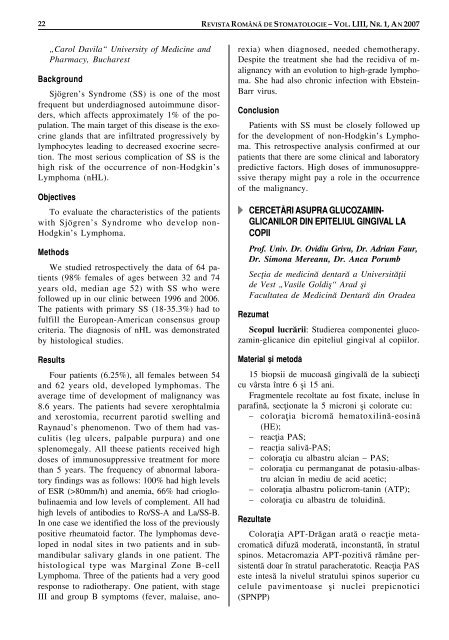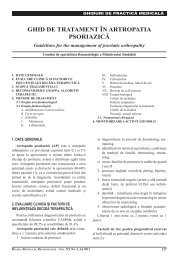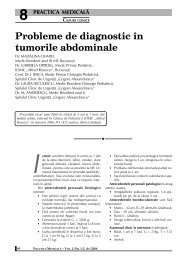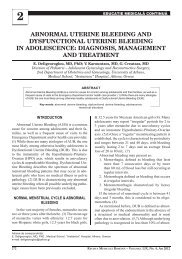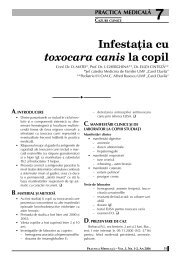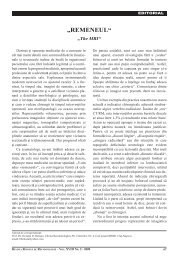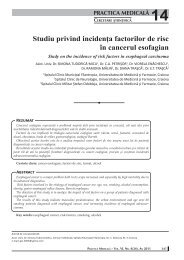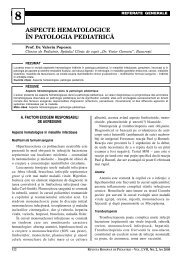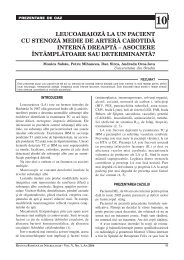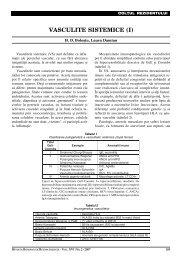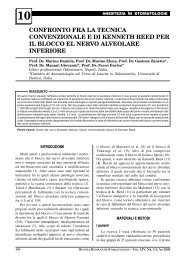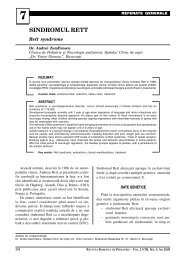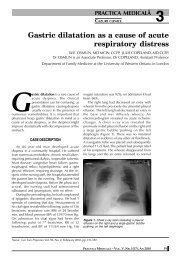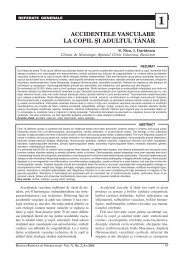Rev. Rom de STOMATOLOGIE nr.1 - 2007.p65 - medica.ro
Rev. Rom de STOMATOLOGIE nr.1 - 2007.p65 - medica.ro
Rev. Rom de STOMATOLOGIE nr.1 - 2007.p65 - medica.ro
Create successful ePaper yourself
Turn your PDF publications into a flip-book with our unique Google optimized e-Paper software.
22 REVISTA ROMÂNÅ DE <st<strong>ro</strong>ng>STOMATOLOGIE</st<strong>ro</strong>ng> – VOL. LIII, NR. 1, AN 2007<br />
„Ca<strong>ro</strong>l Davila“ University of Medicine and<br />
Pharmacy, Bucharest<br />
Backg<strong>ro</strong>und<br />
Sjögren’s Synd<strong>ro</strong>me (SS) is one of the most<br />
frequent but un<st<strong>ro</strong>ng>de</st<strong>ro</strong>ng>rdiagnosed autoimmune disor<st<strong>ro</strong>ng>de</st<strong>ro</strong>ng>rs,<br />
which affects app<strong>ro</strong>ximately 1% of the population.<br />
The main target of this disease is the exocrine<br />
glands that are infiltrated p<strong>ro</strong>gressively by<br />
lymphocytes leading to <st<strong>ro</strong>ng>de</st<strong>ro</strong>ng>creased exocrine secretion.<br />
The most serious complication of SS is the<br />
high risk of the occurrence of non-Hodgkin’s<br />
Lymphoma (nHL).<br />
Objectives<br />
To evaluate the characteristics of the patients<br />
with Sjögren’s Synd<strong>ro</strong>me who <st<strong>ro</strong>ng>de</st<strong>ro</strong>ng>velop non-<br />
Hodgkin’s Lymphoma.<br />
Methods<br />
We studied ret<strong>ro</strong>spectively the data of 64 patients<br />
(98% females of ages between 32 and 74<br />
years old, median age 52) with SS who were<br />
followed up in our clinic between 1996 and 2006.<br />
The patients with primary SS (18-35.3%) had to<br />
fulfill the Eu<strong>ro</strong>pean-American consensus g<strong>ro</strong>up<br />
criteria. The diagnosis of nHL was <st<strong>ro</strong>ng>de</st<strong>ro</strong>ng>monstrated<br />
by histological studies.<br />
Results<br />
Four patients (6.25%), all females between 54<br />
and 62 years old, <st<strong>ro</strong>ng>de</st<strong>ro</strong>ng>veloped lymphomas. The<br />
average time of <st<strong>ro</strong>ng>de</st<strong>ro</strong>ng>velopment of malignancy was<br />
8.6 years. The patients had severe xe<strong>ro</strong>phtalmia<br />
and xe<strong>ro</strong>stomia, recurrent pa<strong>ro</strong>tid swelling and<br />
Raynaud’s phenomenon. Two of them had vasculitis<br />
(leg ulcers, palpable purpura) and one<br />
splenomegaly. All theese patients received high<br />
doses of immunosuppressive treatment for more<br />
than 5 years. The frequency of abnormal laboratory<br />
findings was as follows: 100% had high levels<br />
of ESR (>80mm/h) and anemia, 66% had crioglobulinaemia<br />
and low levels of complement. All had<br />
high levels of antibodies to Ro/SS-A and La/SS-B.<br />
In one case we i<st<strong>ro</strong>ng>de</st<strong>ro</strong>ng>ntified the loss of the previously<br />
positive rheumatoid factor. The lymphomas <st<strong>ro</strong>ng>de</st<strong>ro</strong>ng>veloped<br />
in nodal sites in two patients and in submandibular<br />
salivary glands in one patient. The<br />
histological type was Marginal Zone B-cell<br />
Lymphoma. Three of the patients had a very good<br />
response to radiotherapy. One patient, with stage<br />
III and g<strong>ro</strong>up B symptoms (fever, malaise, ano-<br />
rexia) when diagnosed, nee<st<strong>ro</strong>ng>de</st<strong>ro</strong>ng>d chemotherapy.<br />
Despite the treatment she had the recidiva of malignancy<br />
with an evolution to high-gra<st<strong>ro</strong>ng>de</st<strong>ro</strong>ng> lymphoma.<br />
She had also ch<strong>ro</strong>nic infection with Ebstein-<br />
Barr virus.<br />
Conclusion<br />
Patients with SS must be closely followed up<br />
for the <st<strong>ro</strong>ng>de</st<strong>ro</strong>ng>velopment of non-Hodgkin’s Lymphoma.<br />
This ret<strong>ro</strong>spective analysis confirmed at our<br />
patients that there are some clinical and laboratory<br />
predictive factors. High doses of immunosuppressive<br />
therapy might pay a <strong>ro</strong>le in the occurrence<br />
of the malignancy.<br />
CERCETÅRI ASUPRA GLUCOZAMIN-<br />
GLICANILOR DIN EPITELIUL GINGIVAL LA<br />
COPII<br />
P<strong>ro</strong>f. Univ. Dr. Ovidiu Grivu, Dr. Adrian Faur,<br />
Dr. Simona Mereanu, Dr. Anca Porumb<br />
Sec¡ia <st<strong>ro</strong>ng>de</st<strong>ro</strong>ng> medicinå <st<strong>ro</strong>ng>de</st<strong>ro</strong>ng>ntarå a Universitå¡ii<br />
<st<strong>ro</strong>ng>de</st<strong>ro</strong>ng> Vest „Vasile Goldi¿“ Arad ¿i<br />
Facultatea <st<strong>ro</strong>ng>de</st<strong>ro</strong>ng> Medicinå Dentarå din Ora<st<strong>ro</strong>ng>de</st<strong>ro</strong>ng>a<br />
Rezumat<br />
Scopul lucrårii: Studierea componentei glucozamin-glicanice<br />
din epiteliul gingival al copiilor.<br />
Material ¿i metodå<br />
15 biopsii <st<strong>ro</strong>ng>de</st<strong>ro</strong>ng> mucoaså gingivalå <st<strong>ro</strong>ng>de</st<strong>ro</strong>ng> la subiec¡i<br />
cu vârsta între 6 ¿i 15 ani.<br />
Fragmentele recoltate au fost fixate, incluse în<br />
parafinå, sec¡ionate la 5 mic<strong>ro</strong>ni ¿i colorate cu:<br />
– colora¡ia bic<strong>ro</strong>må hematoxilinå-eosinå<br />
(HE);<br />
– reac¡ia PAS;<br />
– reac¡ia salivå-PAS;<br />
– colora¡ia cu albastru alcian – PAS;<br />
– colora¡ia cu permanganat <st<strong>ro</strong>ng>de</st<strong>ro</strong>ng> potasiu-albastru<br />
alcian în mediu <st<strong>ro</strong>ng>de</st<strong>ro</strong>ng> acid acetic;<br />
– colora¡ia albastru polic<strong>ro</strong>m-tanin (ATP);<br />
– colora¡ia cu albastru <st<strong>ro</strong>ng>de</st<strong>ro</strong>ng> toluidinå.<br />
Rezultate<br />
Colora¡ia APT-Drågan aratå o reac¡ie metac<strong>ro</strong>maticå<br />
difuzå mo<st<strong>ro</strong>ng>de</st<strong>ro</strong>ng>ratå, inconstantå, în stratul<br />
spinos. Metac<strong>ro</strong>mazia APT-pozitivå råmâne persistentå<br />
doar în stratul paracheratotic. Reac¡ia PAS<br />
este inteså la nivelul stratului spinos superior cu<br />
celule pavimentoase ¿i nuclei prepicnotici<br />
(SPNPP)


